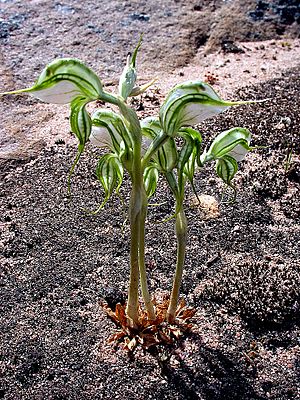Flat rustyhood facts for kids
Quick facts for kids Flat rustyhood |
|
|---|---|
 |
|
| Pterostylis planulata growing in the Grampians National Park | |
| Scientific classification | |
| Genus: |
Pterostylis
|
| Species: |
planulata
|
| Synonyms | |
|
Oligochaetochilus planulatus (David L. Jones & M.A.Clem.) D.L.Jones & M.A.Clem. |
|
The flat rustyhood (Pterostylis planulata) is a special type of orchid found only in Victoria, Australia. It's known for its unique flowers that have green stripes and look a bit like insects! This plant grows from a rosette (a circular cluster) of leaves at its base.
What Does the Flat Rustyhood Look Like?
The flat rustyhood is a perennial plant, meaning it lives for more than two years. It's also a deciduous herb, which means its leaves fall off each year. It grows from an underground tuber, which is like a small storage organ.
At the bottom of its flowering stem, it has a rosette of five to eight leaves. Each leaf is about 18 to 300 millimetres (0.7 to 11.8 inches) long and 5 to 8 millimetres (0.2 to 0.3 inches) wide. Often, these leaves have already withered away by the time the plant flowers.
The plant can have up to seven see-through flowers with green stripes. These flowers are about 30 to 35 millimetres (1.2 to 1.4 inches) long and 9 to 11 millimetres (0.4 to 0.4 inches) wide. They grow on a flowering stem that is 100 to 200 millimetres (3.9 to 7.9 inches) tall. The stem also has three or four leaves wrapped around it.
The top part of the flower, called the "galea," is formed by the dorsal sepal and petals joining together. This galea creates a hood over the flower's central column. The dorsal sepal has a long, thread-like tip that is 20 to 30 millimetres (0.8 to 1.2 inches) long.
The lateral sepals are a bit wider than the galea. They have lots of tiny hairs on their outer edges. These sepals suddenly narrow into a thread-like tip, which is 20 to 35 millimetres (0.8 to 1.4 inches) long. The tips of these lateral sepals usually stay parallel to each other, about 10 millimetres (0.4 inches) apart.
The most interesting part is the labellum, which is like the orchid's "lip." It's thin, green, and looks like an insect! It's about 6 to 7 millimetres (0.2 to 0.3 inches) long and 3 millimetres (0.1 inches) wide. The "head" end of this insect-like labellum has two long bristles. There are also 18 to 24 shorter bristles along its sides.
You can usually see the flat rustyhood flowering from October to November.
How It Got Its Name
The flat rustyhood was first officially described in 1983 by two botanists, David Jones and Mark Clements. They published their description in a scientific journal called Muelleria.
The very first plant specimen used to describe this species was found in the northern part of the Grampians National Park. The second part of its scientific name, planulata, comes from the Latin word planus. This word means "level" or "flat." It refers to how the side sepals of the flower are almost flat, or sometimes slightly curved like a shallow dish.
Where Does It Live?
The flat rustyhood is only found in the northern area of the Grampians National Park in Victoria, Australia. It likes to grow in shallow soil on rock ledges. This means it's quite a rare and special plant!

